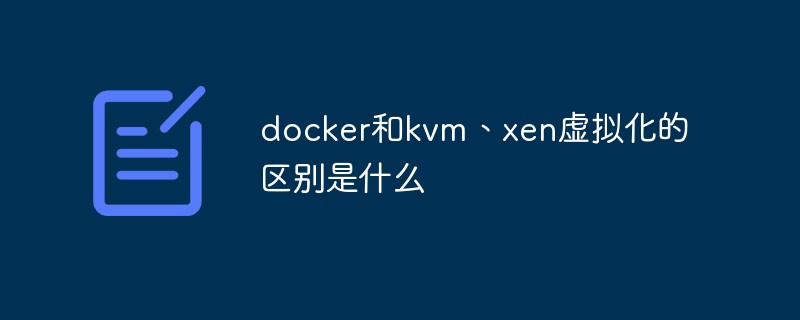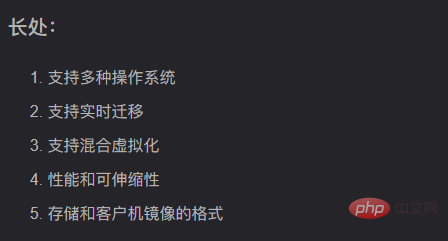 Operation and Maintenance
Operation and Maintenance
 Docker
Docker
 What is the difference between docker, kvm, and xen virtualization?
What is the difference between docker, kvm, and xen virtualization?
What is the difference between docker, kvm, and xen virtualization?
The difference between docker, kvm, and xen virtualization: 1. Docker saves more resources than kvm and can provide performance very close to the host. However, kvm resource isolation is higher than docker, and kvm supports more types of operating systems. More; 2. Docker is containerization and can be started in seconds, which is much faster than kvm and xen virtualization.

The operating environment of this tutorial: linux7.3 system, docker version 19.03, Dell G3 computer.
What is the difference between docker and kvm and xen virtualization?
Summary summary:
docker saves resources than kvm and can provide very close The performance of the host machine, while kvm resource isolation is higher than docker, kvm supports more operating system types
In terms of applications, docker (can withstand tossing, fast deployment), in terms of systems, kvm (host isolation , also supports snapshots)
Separate explanation type:
Docker is containerization, startup can be achieved in seconds, much faster than traditional virtual machines, Docker is The utilization rate of system resources is very high. Thousands of Docker containers can be run simultaneously on one host.
Advantages:
Efficiently utilize system resources
Fast startup time
Consistent running environment
Continuous delivery and deployment
Easier maintenance and expansion
KVM is an open source system virtualization The virtualization module uses liunx's own scheduler management. After using kvm to virtualize multiple physical machines, they form a large virtualized resource pool, which facilitates users to allocate computing power from the resource pool and improve resource usage efficiency. Ensure isolation and security between multi-user resources

Knowledge Expansion
As an emerging virtualization method, Docker has many advantages over traditional virtualization methods.
1. Docker containers can be started in seconds, which is much faster than the traditional virtual machine method. Secondly, Docker has a high utilization rate of system resources. Thousands of Docker containers can be run simultaneously on one host.
2. In addition to running the application in it, the container basically consumes no additional system resources, making the application performance very high and the system overhead as small as possible. The traditional virtual machine method requires 10 virtual machines to run 10 different applications, while Docker only needs to start 10 isolated applications.
3. Virtualization technology relies on physical CPU and memory and is at the hardware level; while docker is built on the operating system and utilizes the containerization technology of the operating system, so docker can even run on a virtual machine.
4. Virtualization systems generally refer to operating system images, which are relatively complex and are called "systems"; while docker is open source and lightweight and is called "containers". A single container is suitable for deploying a small number of applications, such as A redis, a memcached.
5. Traditional virtualization technology uses snapshots to save state; docker is not only more portable and low-cost in saving state, but also introduces a similar source code management mechanism to store the snapshot historical versions of the container one by one. Records, switching costs are low.
6. Traditional virtualization technology is more complex when building the system and requires a lot of manpower; while docker can build the entire container through Dockfile, and restart and build quickly. More importantly, the Dockfile can be written manually, so that application developers can guide the system environment and dependencies by publishing the Dockfile, which is very beneficial to continuous delivery.
7. Of course, KVM also has a big advantage over containers, which is that it can use different operating systems or kernels. So, for example, you could use Microsoft Azure and run an instance of Windows Server 2012 and an instance of SUSE Linux Enterprise Server simultaneously. As for Docker, all containers must use the same operating system and kernel.
Recommended learning: "docker video tutorial"
The above is the detailed content of What is the difference between docker, kvm, and xen virtualization?. For more information, please follow other related articles on the PHP Chinese website!

Hot AI Tools

Undresser.AI Undress
AI-powered app for creating realistic nude photos

AI Clothes Remover
Online AI tool for removing clothes from photos.

Undress AI Tool
Undress images for free

Clothoff.io
AI clothes remover

Video Face Swap
Swap faces in any video effortlessly with our completely free AI face swap tool!

Hot Article

Hot Tools

Notepad++7.3.1
Easy-to-use and free code editor

SublimeText3 Chinese version
Chinese version, very easy to use

Zend Studio 13.0.1
Powerful PHP integrated development environment

Dreamweaver CS6
Visual web development tools

SublimeText3 Mac version
God-level code editing software (SublimeText3)

Hot Topics
 1652
1652
 14
14
 1413
1413
 52
52
 1304
1304
 25
25
 1251
1251
 29
29
 1224
1224
 24
24
 How to exit the container by docker
Apr 15, 2025 pm 12:15 PM
How to exit the container by docker
Apr 15, 2025 pm 12:15 PM
Four ways to exit Docker container: Use Ctrl D in the container terminal Enter exit command in the container terminal Use docker stop <container_name> Command Use docker kill <container_name> command in the host terminal (force exit)
 How to copy files in docker to outside
Apr 15, 2025 pm 12:12 PM
How to copy files in docker to outside
Apr 15, 2025 pm 12:12 PM
Methods for copying files to external hosts in Docker: Use the docker cp command: Execute docker cp [Options] <Container Path> <Host Path>. Using data volumes: Create a directory on the host, and use the -v parameter to mount the directory into the container when creating the container to achieve bidirectional file synchronization.
 How to check the name of the docker container
Apr 15, 2025 pm 12:21 PM
How to check the name of the docker container
Apr 15, 2025 pm 12:21 PM
You can query the Docker container name by following the steps: List all containers (docker ps). Filter the container list (using the grep command). Gets the container name (located in the "NAMES" column).
 How to restart docker
Apr 15, 2025 pm 12:06 PM
How to restart docker
Apr 15, 2025 pm 12:06 PM
How to restart the Docker container: get the container ID (docker ps); stop the container (docker stop <container_id>); start the container (docker start <container_id>); verify that the restart is successful (docker ps). Other methods: Docker Compose (docker-compose restart) or Docker API (see Docker documentation).
 How to start mysql by docker
Apr 15, 2025 pm 12:09 PM
How to start mysql by docker
Apr 15, 2025 pm 12:09 PM
The process of starting MySQL in Docker consists of the following steps: Pull the MySQL image to create and start the container, set the root user password, and map the port verification connection Create the database and the user grants all permissions to the database
 How to start containers by docker
Apr 15, 2025 pm 12:27 PM
How to start containers by docker
Apr 15, 2025 pm 12:27 PM
Docker container startup steps: Pull the container image: Run "docker pull [mirror name]". Create a container: Use "docker create [options] [mirror name] [commands and parameters]". Start the container: Execute "docker start [Container name or ID]". Check container status: Verify that the container is running with "docker ps".
 How to update the image of docker
Apr 15, 2025 pm 12:03 PM
How to update the image of docker
Apr 15, 2025 pm 12:03 PM
The steps to update a Docker image are as follows: Pull the latest image tag New image Delete the old image for a specific tag (optional) Restart the container (if needed)
 How to create containers for docker
Apr 15, 2025 pm 12:18 PM
How to create containers for docker
Apr 15, 2025 pm 12:18 PM
Create a container in Docker: 1. Pull the image: docker pull [mirror name] 2. Create a container: docker run [Options] [mirror name] [Command] 3. Start the container: docker start [Container name]



